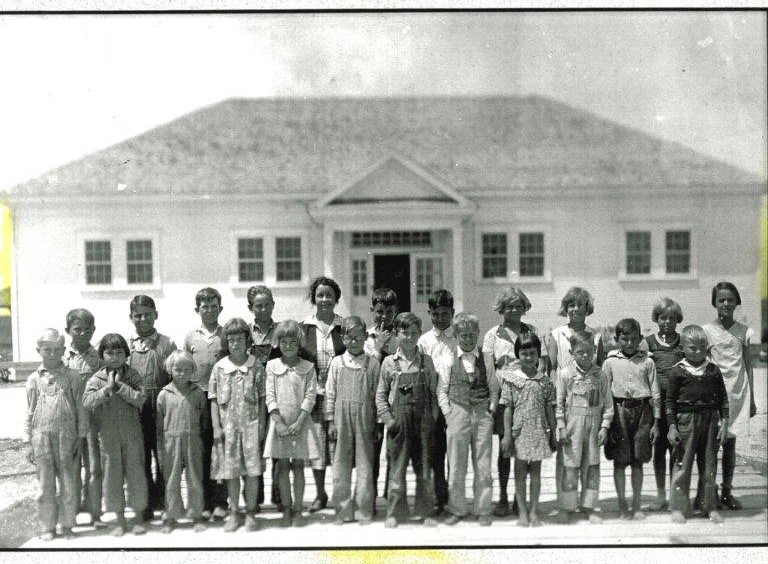This article originally appeared in the Garland/Mesquite section of The Dallas Morning News on October 6, 1995.
By Michael R. Hayslip
The Handley community, identified with the Handley School once located across from the present E-Systems plant on Jupiter Road, was an unincorporated farming area generally bounded by Walnut Street, Kingsley Road, Shiloh Road and Plano Road. In a sense it overlapped “Wyrickville on the Pike,” a cluster of homes and buildings surrounding the J. S. Wyrick Grocery and General Merchandise establishment operating a mile south of the school on the west side of Jupiter Road.
Established in 1923 the by the Dallas County school trustees, the Handley School emerged from a consolidation of the old Lawler School, located on Lawler Road just west of Jupiter Road, with the West Garland School, located due east on the west side of Shiloh. Both the Lawler and West Garland Schools had begun operating at least as early as the 1890s, according to recollections written for the Garland Local History and Genealogical Society Quarterly of June 1973.
While the Lawler and Handley schools bore the surnames of early families farming in the vicinity and were governed by three local trustees, their funding came primarily from county tax collections, since they lay outside the boundaries of any independent school district at the time. County school supervisors regularly audited the instruction. But like other county-operated schools, their facilities were also used during off hours for civic and religious purposes. Consequently, the school faculty sometimes began the day by clearing out cigarette butts and other miscellanea that accumulated during non-school functions.
Mrs. Grace Davis Glaze, who taught at the school, says that it was built by A. Quesenberry and Son, a well-known Garland contractor. A modified one-room layout divided the building into halves, so that first through third grade pupils sat in the north end with third through sixth graders in the south. As many as four teachers wrestled simultaneously with instruction, even on cold days, when students clustered as close as possible to the pot-bellied stove which sat between the groups.
Among the teachers who taught at the school in at various times besides Mrs. Glaze were Imogene Taft (Castle), Nona Mae Roper (McDowell), Irene Johnson (Brackett), Jewell McCracken and Gabe Massey.
The Handley School complex included what was called a tabernacle (open shed) in back and was served by both a water well and two, 2-hole detached privies. Females were accommodated in the convenience to the north of the main building, while males were assigned to the one to the south. An east-west drainage ditch, whose mud and water were traversed by a foot bridge, ran between the main building and the southern rest facility, posing an almost irresistible temptation for boys to jump, rather than walk, across to their destination, even at risk of swift reprisal from the faculty.
Weldon Bell and Loyd Bryant, both Handley alumni, vividly recall the time that a student arsonist torched some paper stuffed inside the walls of the private structure for men and boys. Even though the school’s well was close by, a frantic bucket brigade failed to quench the resulting flames until the destruction was almost complete. Bell later became a Dallas firefighter and is now retired.
By 1939, due to attrition to other schools, Handley’s enrollment had dwindled to eight pupils, and Garland school trustees wanted to annex its surrounding properties to swell the GISD tax roll. Despite die-hard opposition from some nearby residents, who viewed Garland school taxes with hostility, the consolidation was completed. Mrs. Glaze, the sole remaining teacher, joined the Garland elementary school faculty, and the Handley building was removed to the Garland High School campus, where it became the band hall.

First, second and third grade students of Miss Grace Davis pictured at Handley School about 1930 include: Front row (l-r)-Emmett Glasgow, James Naylor, Weldon Bell, Claude Smith, Jessie Ray Wyrick, J. C. Wyrick, Opie Ausbrook, Jack Tabor, J. B. Barnard; second row (l-r) Clayton Pierce, Louise Adams, Pauline Pierce, Virginia Farley, Helen Ogle, Margaret Ausbrook, Lenore Merriman, Ida Goforth, Emma Naylor, Lilly Belle Naylor, Zeb Bryant, Edward Farley; third row (l-r) Weldon Osborn, Bertha Fay Grandstaff, Winnie Duckworth, Willie Mae Grandstaff, Miss Davis, Annie Ruth Jolley, Myrtle Naylor, Jonnie Crowder, Julie May Naylor, Janet Jolley, Joe Merriman; back row (l-r) W. F. French, Jr., Erskine Ausbrook, Clay Ausbrook, Murray Ogle, James French, Thomas Duckworth, Charles Bell, George Grandstaff.
Photo courtesy Weldon Bell

